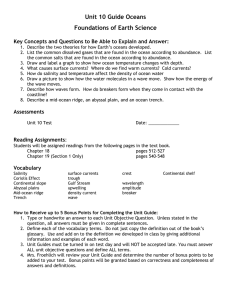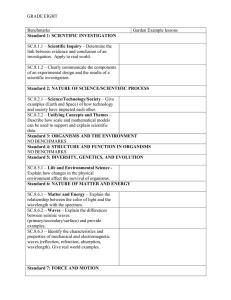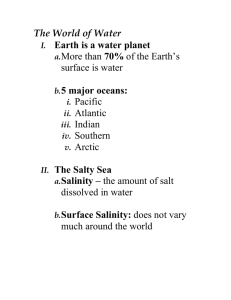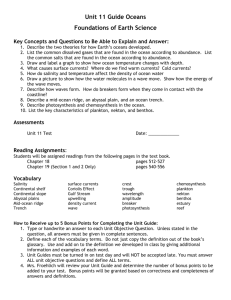Oceanography Final Exam Review: The Answers
advertisement
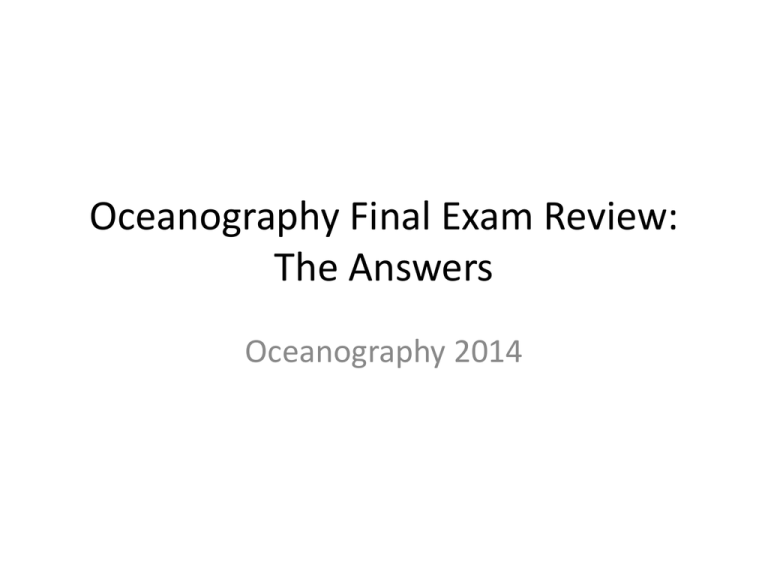
Oceanography Final Exam Review: The Answers Oceanography 2014 1. Chronometer • Accurate maritime clock • Invented by John Harrison 1735 2. What contributions did the Chinese make to sailing? MOST IMPORTANT = compass 3. Latitude and Longitude in the N Hemisphere Calculated by… • Latitude: measuring the angle between the horizon and the north star • Longitude: knowing the difference between local time and Greenwich mean-time 4. Describe the purpose of the Challenger Expedition. It was the first expedition devoted entirely to marine science 5. Define the 4 major categories of oceanography. Physical: Study of Waves, Currents, and Tides Geological: Study of Ocean Rocks, Sediment, & Volcanic Activity Chemical: Study of Water Chemistry Biological: Study of Ocean Life / Marine Biology 6. Who was the father of physical oceanography? Matthew Maury 7. Life Style Groups PLANKTON Microscopic floating organisms, some photosynthesize and some eat other organisms BENTHOS Organisms that live on the ocean bottom, some can move and some are stationary NEKTON Organisms that can swim, includes many vertebrate animals and some invertebrates like squid 8. Light in the Ocean PHOTIC APHOTIC ABYSSAL 9. What is taxonomy? Grouping organisms together and determining their relationships 10. What are some ways taxonomy is useful? • identifies the relationship between organisms • requires that key characteristics be defined for each organism • helps to avoid confusion 11. Who created the current classification system? Carolus Linneaus 12-13. What groups are in this system? How can you remember them in order from largest to smallest? domain, kingdom, phylum, class, order, family, genus, species D –ear K –ing P –hillip C –ame O –ver F –or G –reat S -paghetti 14. Examples of scientific names. Genus species Homo sapien (HUMANS) Felis catus (DOMESTIC CAT) Canis familiaris (DOMESTIC DOG) Ursus americanus (BLACK BEAR) 15-19. Characteristics of the Kingdoms • Animalia (multicellular, heterotrophic) – Dog • Plantae (multicellular, autotrophic) – Daisy • Archaea (unicellular, autotrophic) – Extremophiles • Eubacteria (unicellular, auto&hetero-trophic) – E. Coli • Protista (unicellular, auto&hetero-trophic) – Algae, Kelp 20. Dichotomous Key Purpose: Helps with identifying organisms based on appearance Answers: 1. Peacock Flounder 2. Spotted Goat Fish 3. Glassy Sweeper 4. Squirrel Fish 5. Spotted Eagle Ray 6. Band-tail Puffer 7. Spotted Moray Eel 8. Glass-Eye Snapper 9. Trumpet Fish 21. Phylogeny Different from taxonomy because it groups organisms based on similar characteristics instead of ancestral relationships 22. What is it called when an organism is able to produce light? Bioluminescence 23. Phytoplankton Plankton that generate energy through photosynthesis 24. Echolocation It is a series of high-pitched clicks and whistles used by whales and dolphins for communication 25. What is a cephalopod? Squid and Octopi Means: “head” – “foot” 26. Sea Sponge • Benthic Marine Invertebrate • Called “filter of the sea” because it is porous and feeds via filter-feeding 27. Bivalvia • Clams and Oysters • Marine Invertebrates with 2-half shells 28. Crustacea • Crabs and Lobsters • Hard Exoskeleton, segmented bodies 29. Echinodermata • Marine invertebrates such as starfish and sea urchins • Have radial symmetry (same no matter which way you cut it) 30-36. Sharks 30. Chordata ; Nekton 31. Cartilaginous 32. Large, fatty organ used to help sharks float 33. Hunting sharks eat dolphin, seal, and squid ; peaceful sharks eat plankton/algae 34. Valuable for soup in some Asian countries 35. Sharks are slow-growing to maturity and have few offspring 36. Sharks have skeletons of cartilage instead of bone, they give birth to live offspring instead of lay eggs, dermal denticles instead of scales, and fatty liver instead of swim bladder 37. Freshwater and Saltwater • 3% Fresh • 97% Salt 38. H2O Molecule + + - 39. What is a polar molecule? Molecules with a positive end and a negative ends 40. What type of bonds hold water molecules together? Covalent 41. What are the 5 Key Properties of Water? 1. Cohesion/Adhesion (water sticks to itself, and other objects) 2. Surface Tension (insect can walk on water) 3. Viscosity (water resists motion) 4. Liquid Water (exists as liquid not gas at room temp) 5. Ice Floats (solid is less dense than liquid) 42. What factors will affect the way sound moves through seawater? • Temperature • Salinity • Pressure 43. Salinity The measurement of dissolved solids in seawater Measured in PPT (parts per thousand) Average salinity of ocean = 35 44. Where does the salt in the ocean originate from? Salt is washed into the ocean from sources on the land 45-47. pH Basic 45. Acids and Bases, Concentration of ions in a liquid 46. Neutral = 7 (pure water) 47. Optimal for living things = 6-8 48. Density D = M/V the measure of how compact a substance is per unit area 49. Why is water considered the universal solvent? Because of its ability to dissolve most substances 50. Why is the Earth “unevenly heated” by the Sun? Due to its… • rotation • tilt • imperfect shape 51. What are convection currents? Air currents that cause polar air to sink and equatorial air to rise 52. Winds blow from regions of _________ pressure to regions of __________ pressure. From regions of high pressure to regions of low pressure 53. What is the Coriolis Effect and why is it important? Phenomenon caused by the rotation of Earth that leads to: Northern Hemisphere: Clockwise Southern Hemisphere: Counter-clockwise Effects the paths in which winds/currents move 54. Earth’s Atmosphere About 70-78% Nitrogen 55. Role of Trade Winds and Surface Currents on Exploration • Created “paths” for sailing ships, expeditions followed the winds/currents • Gyres provided “round trip” transport 56. World Gyres GYRE: intersection of ocean currents that creates a circular pattern of water flow 57. What causes surface currents to form? Wind 58. Thermohaline Circulation • Caused by differences in density related to salinity and temperature • Creates deep ocean currents


